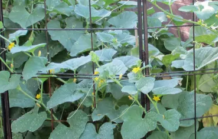https://hnr.k-state.edu/extension/info-center/newsletters/index.html
Blog Post: http://www.ksuhortnewsletter.org
Video of the Week: Planting Bulbs for Spring Color
https://kansashealthyyards.org/all-videos/video/bulbs-planting-for-spring-color
UPCOMING EVENTS
Kansas Forest Service Tree, Shrub Seedling Sale, September 1 – October 15
https://www.kansasforests.org/conservation_trees/
REMINDERS
• Divide perennials such as peonies and daylilies if needed.
• Prune broken and dead branches from trees.
• Remove suckers and watersprouts from fruit trees.
ORNAMENTALS
Time to Plant Spring-flowering Bulbs Approaching
Late September through October is an excellent time to plant spring-flowering bulbs such as crocus, tulips, and daffodils. These plants need to develop roots in the fall and must meet a chilling requirement over the winter in order to bloom in the spring.
Choose a planting site that has full sun to partial shade. The ideal soil would be a sandy loam, but even poor soils can be used if organic material such as peat moss, compost, or aged bark is mixed in. For example, a heavy clay can be amended by mixing in one-third to one-half organic material. Soil pH should be between 6.0 and 7.0.
Bulbs need good aeration as well as good drainage for proper development. It is best if the bulbs are given 12 inches of prepared soil. If one-third organic material were added, this would require mixing 4 inches of organic material with 8 inches of soil. Incorporate about 3 pounds of a complete fertilizer such as a 5-10-5 per 100 square feet during preparation or fertilize according to soil test.
Planting depths vary depending on the size of the bulbs. For example, tulips and hyacinths are set about 6 inches deep, and daffodils are put 6 to 8 inches deep. Smaller bulbs are planted shallower. As a rule of thumb, bulbs are planted two to three times as deep as their width. Planting depth is the distance from the bottom of the bulb to the top of the soil. Large bulbs are normally spaced 4 to 6 inches apart, and small bulbs about 1 to 2 inches. Planting in clumps or irregular masses produces a better display than planting singly.
After placing the bulbs at the proper depth, replace half the soil and add water. This will settle the soil around the bulbs and provide good bulb/soil contact. Add the remaining soil and water again. Although there will be no top growth in the fall, the roots are developing, so soil needs to be kept moist but not soggy. Mulch can be added after the soil has frozen to prevent small bulbs from being heaved out of the soil by alternate freezing and thawing. (Ward Upham)
VEGETABLES
Adding Organic Materials Directly to the Garden
If the summer weather has brought an early end to your garden, consider adding organic materials directly to the soil rather than composting. Materials such as residue from lawn renovation, rotted hay, old mulch or rotted silage can be added and then tilled in. Leaves fallen from trees can be added as they become available. Most grass clippings can also be tilled in but avoid grass clipping from lawns that have been sprayed with a crabgrass killer. This product can carry over and harm the garden the following year. Crabgrass preventers applied in the spring are fine but crabgrass killers are not.
Organic materials can be spread to a depth of about 3 inches and tilled or dug in. Coarser materials such as tree leaves or garden residue should be shredded before tilling. A lawn mower with a bagging attachment can be used to shred this material and collect it in one operation. Be sure the soil is not too wet before tilling. During warm weather, the material will decompose quickly and the process can be repeated every two weeks. Later in the fall, it may take longer. This process can be repeated from now until late November to early December.
Remember that organic matter helps almost any soil. It improves clay soil by improving tilth, aeration and how quickly the soil takes up water. In sandy soils, it acts as a sponge by holding water and nutrients. (Ward Upham)
MISCELLANEOUS
Reblooming Poinsettias
If you have saved last year’s poinsettia and want it to flower again this year, you must follow certain procedures. Poinsettias are known as “short-day” plants. Growers found out long ago that poinsettias can be brought into bloom if they are given short days and long nights.
Originally, it was thought that short-day plants needed a short duration of daylight in order to flower. Now we know that flower formation is actually triggered by long periods of uninterrupted darkness. For poinsettia, at least 12 hours of each 24 must be uninterrupted dark. Night temperature also has an effect and should be below 70 degrees F with 60 to 65 degrees F preferred.
During the day, place the plants in the sunniest location of the house. This high level of light is needed for the plants to have the energy required for good bract coloration. Day temperatures should range between 65 and 75 degrees F.
Providing uninterrupted darkness can be a problem for gardeners unless there is a room in which the lights are never turned on. If you don’t have such a room, place your poinsettia in a dark closet or cover it with a cardboard box each night for the required 12 hours. If using a cardboard box, tape all the seams with duct tape to cut off any light. Poinsettia takes anywhere between eight and 11 weeks to flower once the dark treatment has been started. Normally, people start the dark treatment in late September to early October. The first six weeks are critical as this triggers the plant to bloom. The remaining time is needed for flowers to develop. For every night you miss during the first six weeks, add two days to the bloom time.
After the six-week dark treatment, the buds have set and the dark treatment is no longer needed. (Ward Upham)
Planting Trees in the Fall
The fall season can be an excellent time to plant trees. During the spring, soils are cold and may be so wet that low oxygen levels inhibit root growth. The warm and moist soils normally associated with fall encourage root growth. Fall root growth means the tree becomes established months before a spring-planted tree and is better able to withstand summer stresses. The best time to plant trees in the fall is early September to late October. This is early enough that roots can become established before the ground freezes. Unfortunately, certain trees do not produce significant root growth during the fall and are better planted in the spring. These include beech, birch, redbud, magnolia, tulip poplar, willow oak, scarlet oak, black oak, willows, and dogwood.
Fall-planted trees require some special care. Remember, that roots are actively growing even though the top is dormant. Make sure the soil stays moist but not soggy. This may require watering not only in the fall but also during the winter months if we experience warm spells that dry the soil. Mulch also is helpful because it minimizes moisture loss and slows the cooling of the soil so root growth continues as long as possible. (Ward Upham)
Moving Houseplants Inside for the Winter
Many people with houseplants move some of them outside for the summer to give them better growing conditions and help them recover from the stress of an indoor environment. If the plants haven’t been brought inside yet, now would be a good time. Plants that have spent the summer outside should be inspected for insects and disease before bringing them inside. A sharp spray from a garden hose can remove insects or mites from houseplant foliage. Insects in the potting soil can be forced out by soaking the pot in a tub of lukewarm water for about 15 minutes.
Houseplants that have been kept outdoors are accustomed to receiving much more sunlight than they do indoors. So how do we help houseplants acclimatize to the lower light levels inside? Houseplants brought in from outside should be started out in an area of the home that receives plenty of light, and then gradually moved to their permanent, darker location. This process should take four to eight weeks depending on the degree of difference in light levels between the initial and final location of the plant.
Understanding plant processes allows us to anticipate potential problems. Acclimatization gives houseplants a greater chance of retaining leaves and avoiding the stress of completely replacing them. (Ward Upham)
Root Cellars
Root cellars have been used for centuries to help store food during cold weather. Produce that have traditionally been stored in root cellars include apples, pears, onions, garlic, turnips, squash, carrots, potatoes and various other fruits, nuts and vegetables. Remember that potatoes stored below 40 degrees will often lead to starches being converted to sugars, which will give tubers an undesirable sweet taste. Placing potatoes at room temperature for 2 to 3 days will allow sugars to be converted back to starches and remove the objectionable taste.
What is most important for storing produce? The two variables that are most important to control when using a root cellar are temperature and humidity.
Temperature: For best results, we want to keep the temperature between 32 and 40 degrees. Allowing the temperature to rise above 40 degrees will cause the produce to deteriorate more quickly.
Humidity: Keeping the humidity level between 85 and 95% will keep produce from shriveling due to moisture loss.
There are number of methods and materials used to make root cellars. For example, a root cellar can be made from straw bales, trash cans, buried barrels, drain tiles, trenches, crawl spaces, new septic tanks, earth pits, outbuildings and basements. Building plans are beyond the scope of this article, however, an internet search can provide plenty of ideas. (Ward Upham)
Contributors: Ward Upham, Extension Associate
Division of Horticulture
1712 Claflin, 2021 Throckmorton
Manhattan, KS 66506
(785) 532-6173
For questions or further information, contact: wupham@ksu.edu OR cdipman@ksu.edu
This newsletter is also available on the World Wide Web at:
http://hnr.k-state.edu/extension/info-center/newsletters/index.html
The web version includes color images that illustrate subjects discussed. To subscribe to this newsletter electronically, send an e-mail message to cdipman@ksu.edu or wupham@ksu.edu listing your e-mail address in the message.
Brand names appearing in this newsletter are for product identification purposes only. No endorsement is intended, nor is criticism implied of similar products not mentioned.
K-State Research and Extension is committed to making its services, activities and programs accessible to all participants. If you have special requirements due to a physical, vision or hearing disability, or a dietary restriction please contact Extension Horticulture at (785) 532-6173.
Kansas State University Agricultural Experiment Station and Cooperative Extension Service K-State Research and Extension is an equal opportunity employer. Issued in furtherance of Cooperative Extension Work, Acts of May 8 and June 30, 1914, as amended. Kansas State University, County Extension Councils, and United States Department of Agriculture Cooperating, Ernie Minton, Dean.





